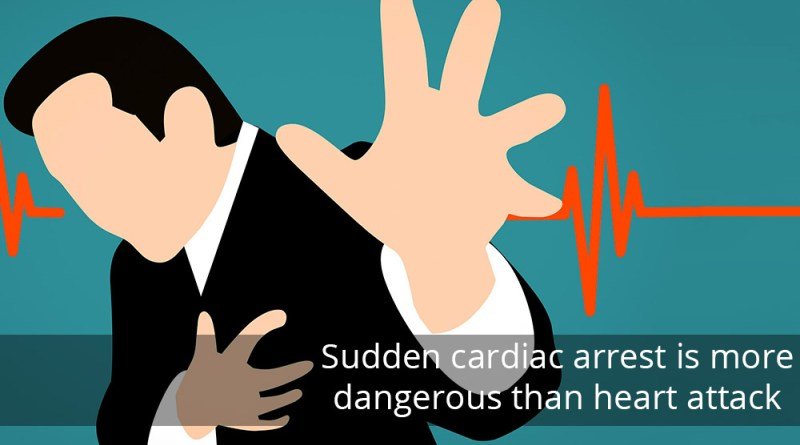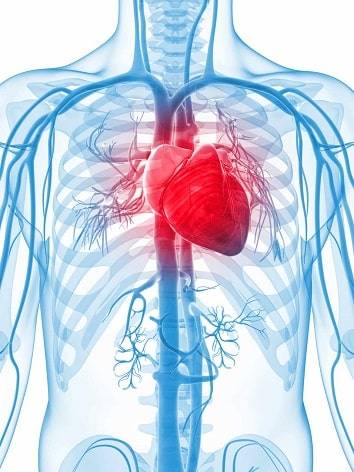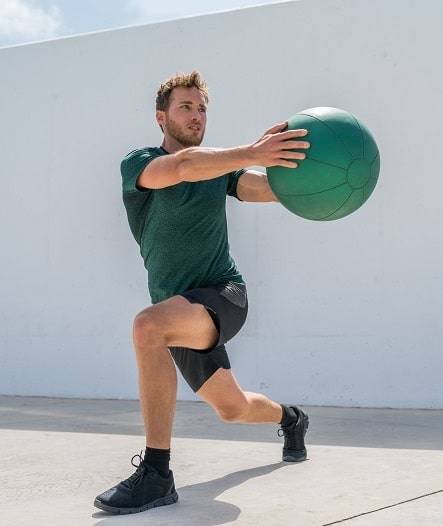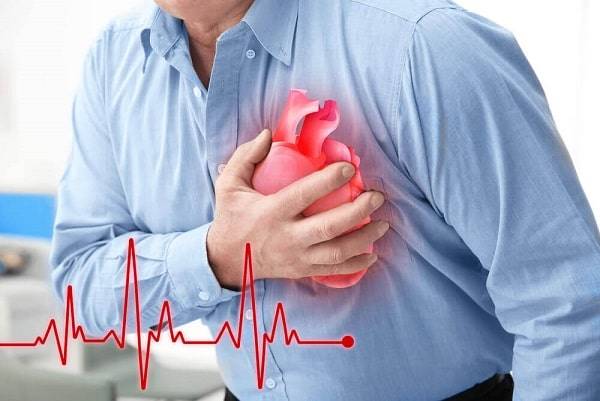Heart Attack vs. Cardiac Arrest
Some people consider a heart attack and a cardiac arrest to be the same thing.
However, they are totally different as they represent two different conditions.
1. Heart attack [1,2]:
A heart attack is a layman’s word for what is scientifically known as “acute coronary syndrome”.
It is caused by blockage or severe spasm of one or more of the arteries supplying the heart (coronary arteries) due to deposition of fat and other materials in the blood vessel walls (a process called atherosclerosis).
Acute coronary syndrome includes a group of diseases which can be classified under two categories:
- Unstable angina.
- Myocardial infarction.
They differ in that for unstable angina, no actual damage has happened to the heart muscle while in myocardial infarction some of the heart muscle cells get destroyed.
In a heart attack, the patient usually experiences chest pain, shortness of breath or undue fatigue that is usually caused by exertion (like brisk walking, climbing stairs… etc) or by stress.
These symptoms are usually relieved by resting.
It is mandatory to seek urgent medical attention by calling 999 and going to the emergency room.
Would you like to improve your heart health, reach your rehab goals safe and maximise exercise effectiveness?
If the answer is yes then, – contact me now HERE.
For limited time availability request now your, FREE CONSULTATION!
2. Cardiac arrest [3,4]:
A cardiac arrest is when the heart suddenly malfunctions and stops beating causing the person to collapse, fall unconscious and stop breathing.
In the UK there are over 30,000 cardiac arrests a year outside of hospital where the emergency medical services attempt to resuscitate the victim [5].
To understand the difference, you may think of a heart attack as a problem with blood circulation and a cardiac arrest as an electrical problem.
A cardiac arrest develops suddenly, usually without warning and is due to a problem with the heart’s beating (arrhythmia).
This leads to interruption of the heart’s pumping of blood to the brain, lungs, liver, kidneys and other vital organs.
A person in cardiac arrest will die within a few minutes if he/she isn’t immediately treated.

If you witness a victim of a cardiac arrest, immediately call 999 and start cardiopulmonary resuscitation (CPR).
If an automated external defibrillator (AED) is available use it.
Causes of a Heart Attack and a Cardiac Arrest
Most heart attacks don’t cause cardiac arrest, however, when a cardiac arrest happens it is mostly due to a heart attack.
1. Causes of a heart attack [6,7]:
A person with a heart attack will usually have one or more of the risk factors that cause atherosclerosis and narrowing of coronary arteries, such as:
- Smoking (regardless of amount and duration).
- High blood pressure (not properly controlled by medications).
- Diabetes mellitus (high blood sugar).
- High blood cholesterol levels (especially the harmful low-density lipoprotein cholesterol (LDL-C)).
- A close family member with history of coronary heart disease at a young age (less than 55 years in males and 65 for females).
- Obesity or being overweight (with a body mass index (BMI) more than or equal to 25 kg/m2).
- A poor diet – not customised to the client needs, it is unbalanced, not following guidelines and having large amounts of sugar, juices, process foods, fat, especially harmful fat such as trans fatty acids.
 2. Causes of a cardiac arrest [3,4]:
2. Causes of a cardiac arrest [3,4]:
A cardiac arrest is usually caused by an arrhythmia which causes the heart to stop beating and hence stop pumping blood.
This can be caused by:
- Ventricular fibrillation: A “chaotic” beating of the heart that doesn’t follow the normal conduction track inside the heart and thus doesn’t cause any pumping of the heart leading to a total stop of the blood circulation.
- Asystole: Complete loss of any form of electrical activity in the heart. Also called baseline.
- Respiratory arrest: This is a different form of arrest that starts due to problems with breathing that lead to decreased oxygen supply to the heart and other vital organs eventually causing cardiac arrest. It can occur with:
- Advanced chest diseases.
- Choking
- Drowning
- Recreational use of drugs.
- In appropriate use of certain heart medications.
- Extreme situations, such as:
- Electric shock.
- Hypothermia.
- Starvation and dehydration.
Would you like to improve your heart health, reach your rehab goals safe and maximise exercise effectiveness?
If the answer is yes then, – contact me now HERE.
For limited time availability request now your, FREE CONSULTATION!
Different Symptoms of a Heart Attack and a Cardiac Arrest
Since heart attacks and a cardiac arrest are different conditions, they have different presenting symptoms.
- Heart attack symptoms [6,7]:
- Most symptoms of a heart attack happen in relation to physical exertion or a stressful condition.
- The symptoms may be short-lived or prolonged with the person starting to feel unwell and anxious, such as:
- Sudden feeling of burning or compressing pain or pressure in the centre of the chest which may extend to the shoulders and arms (especially the left side), neck, jaw or upper abdomen.
- Severe shortness of breath that is occasionally associated with coughing or wheezing sounds.
- A sense of unexplained fatigue and tiredness that isn’t matching with the level of activity performed.
- Marked sweating or the sense of a cold sweat.
- A sense of impending doom.
- Dizziness and a sense of fainting.
- Cardiac arrest symptoms [3,4]:
- Cardiac arrest often occurs with no warning signs:
- Sudden collapse.
- Sudden loss of consciousness: That will usually result in the patient falling to the ground.
- Victim is seen not breathing: By looking at the chest movements or listening for breaths this can be easily identified.
- Victim doesn’t move or respond to verbal or contact stimuli: Which means if you try to provoke a movement by something like pinching the victim it will be unsuccessful
- No pulse could be felt or heard: Listen with your ear directly on the left side of the chest or try to feel a pulse in the neck.
- Sometimes there are symptoms that happen before going into cardiac arrest, such as:
- Fatigue, fainting, blackouts, and dizziness.
- Chest pain, shortness of breath and palpitations.
- Weakness or vomiting.
Are you looking to improve your heart health, ensure safety whilst exercise and rehab effectiveness?
If the answer is yes – contact me now HERE.
For limited time availability request now your, FREE CONSULTATION!
What to Do in case of a Cardiac Arrest and a Heart Attack
“Fast Action can save lives”
A cardiac arrest and a heart attack are both very serious conditions that require immediate action.
However, a cardiac arrest is much more serious than a heart attack because death can occur within minutes if immediate management isn’t provided.
1. Cardiac arrest [8]:
- The people who might rescue a cardiac arrest victim are those who witness it.
- They are called the “bystanders”. They are the ones who need to act IMMEDIATELY if there’s going to be a chance to reverse the cardiac arrest.
- How to act if only one person witnesses a cardiac arrest?
- Start CPR immediately!At the same time call for help or call 999 if there is no help around.
- If you aren’t trained, CPR is performed by providing continuous chest compressions without any rescue breaths until help arrives.
- If you are trained and confident, alternate 30 chest compressions with two rescue breaths.
- You can time your chest compressions using one of the following:
- Counting in “one-one thousand, two-one thousand, three-one thousand… etc.”
- Using the beat of the famous disco song “Staying Alive.”
- Stay with the victim and don’t leave.
- Stop only if there are signs of life or when help arrives.
- How to act if two or more people witness a cardiac arrest?
- One starts chest compressions immediately and the other calls for help or calls 999.
- You should take turns in chest compressions following the above-mentioned recommendations.
- If you are somewhere with an AED available use it and comply with its instructions.
2. Heart attack [7]:
If you experience a heart attack:
- It is important to try to remain calm and breath slowly and regularly.
- Don’t panic!
- Try to lie down or sit down.
- Call 999 immediately to take you to the ER.
- Make sure to give the paramedics your full medical history.
- If your unwell and can’t speak, try to get them to contact a next of kin who is aware of any medical condition you might have.
Would you like to improve your heart health, reach your rehab goals safe and maximise your exercise rehab effectiveness?
If the answer is yes then, – contact me now HERE.
For limited time availability request now your, FREE CONSULTATION!
Recovery after a Heart attack or a Cardiac Arrest
Survivors of heart attacks and cardiac arrest are required to take life-changing decisions to manage such traumatic experiences to try to guarantee that such a condition wouldn’t happen again.
This is especially important for cardiac arrest survivors since they are the lucky two to eight per cent who manage to survive in out-of-hospital cardiac arrests according to UK statistics [9].

These life-changing decisions include [6,10]:
- Registering for a Cardiac Rehabilitation programme:
Cardiac rehabilitation programmes are comprehensive programmes designed and delivered by a group of skilled specialists, including a cardiologist, a physical therapist, an elite personal trainer in London, a nutritionist, lifestyle coaches, a psychologist and nurses.
- Performing a full Makeover of your Lifestyle:
It is important to be aware that in most cases heart attacks and cardiac arrest occur due to certain risk factors that you may have.
Most of these risk factors are modifiable.
However, this requires expert nutrition customisation but, also a strong will to commit to the necessary lifestyle changes including adherence to prescribed medications, weight loss, regular physical activity and implementing new dietary habits.
- Enrolling in a well-designed exercise programme:
A tailored exercise programme will put you on the right track providing you with a safe, effective and customised fitness rehabilitation programme and ensuring continuous motivation.
- Eating Customised For Your Risk Factors, Challenges and Goals:
Key word here, is “nutrition customisation” and healthy food options that provide you with the balanced nutrients intakes required for a healthy heart which might be rich in fruits, vegetables, whole grains, and high-fibre with a very limited amount of saturated fat, sodium, process foods, commercial juices and sugar.
Everything must be customised to your challenges and specific needs.
- Quitting Smoking:
Smoking is a major risk factor for both conditions and complete quitting is mandatory if you want to keep your heart safe from any repeated attacks.
- Controlling other Risk Factors that could cause heart attacks and cardiac arrest:
- High blood sugar.
- High blood pressure.
- High blood cholesterol levels.
- Depression and continuous stress exposure.
All about Cardiac Rehabilitation[11,12]
What is cardiac rehabilitation for heart attack recovery?
The definition of cardiac rehabilitation according to the World Health Organisation (WHO) is “all activities and interventions required to ensure the best possible physical, mental, and social conditions so that patients with cardiovascular disease may, by their own efforts, preserve or resume their proper place in society and lead an active life” [13].
A cardiac rehabilitation programme includes customised exercise, education, and behavioural changes that help patients during heart attack recovery achieve their goals of restoring and maintaining optimal health whilst reducing the risk of a repeat heart attack.
What does cardiac rehabilitation do?
- Cardiac rehabilitation significantly reduces the risk of death from a recurrent heart attack or cardiac arrest.
- It markedly reduces the symptoms related to coronary heart disease.
- Manages the psychological effects of heart disease by improving a patient’s psychological, social and vocational status.
Would you like to improve your heart health, reach your rehab goals safe and maximise exercise rehabilitation effectiveness?
If the answer is yes then, – contact me now HERE.
For limited time availability request now your, FREE CONSULTATION!
Cardiac rehabilitation programmes
A proper cardiac rehabilitation exercise programme requires a customised team effort to achieve its goals.
Hence, the team mentioned before must be working in harmony together to provide the client with a risk free and effective rehab programme that has been tailored to client needs.
For a cardiac rehabilitation programme to be both safe and effective, it must be tailored, achieve the balance of not being too hard (to avoid possible harm) and not being too easy (to ensure effectiveness and provide the required benefits to the heart and body).
It must also take into account old or new injuries, any type of limitations, imbalances and postural adjustments to ensure that the programme is perfectly customised for the client needs and overall it is both effective and balanced.
Completing the whole duration of the programme is necessary if the expected benefits are to be achieved.
Scientific research has proved that the only way to gain the life-changing benefits of a cardiac rehabilitation programme is by completing the whole rehab programme and not just attending a few sessions.
Customised exercise training is important and it has been shown that fine tailoring will reduce the risks whilst create the major part of the benefits a cardiac rehabilitation programme has to offer.
Personalised Rehabilitation Programmes by Jazz Alessi
I am an Elite Personal Trainer in London, Rehabilitation Exercise Specialist, Second Generation Pilates Trainer, long term London Nutritionist and Weight Loss Expert.
I will work with your cardiologist and create a safe and effective cardiac rehabilitation programme tailored to your unique needs as advised or required by your cardiologist.

I strictly follow an evidence-based approach to fitness, exercise and cardiac rehabilitation to guarantee the best results.
Your safety and health are my priority.
I continuously work with clients with heart disease and have a deep understanding of all forms of cardiovascular ailments.
Alongside your cardiologist I’m able to provide you with expert programme approach to manage them through exercise, customised nutrition diet plan and effective lifestyle changes.
Would you like to improve your heart health, ensure exercise rehab safety and maximise exercise effectiveness?
If the answer is yes – contact me now HERE.
For limited time request now your, FREE CONSULTATION!
References:
- Makki N, Brennan T, Girotra S. Acute coronary syndrome.J Intensive Care Med. 2015 May;30(4):186-200. doi: 10.1177/0885066613503294.
http://journals.sagepub.com/doi/pdf/10.1177/0885066613503294
- National Heart, Lung and Blood Institute. What Is a Heart Attack? 2017
https://www.nhlbi.nih.gov/health/health-topics/topics/heartattack
- Patil K, Halperin H, Becker L. Cardiac arrest: resuscitation and reperfusion.Circ Res. 2015 Jun 5;116(12):2041-9. doi: 10.1161/CIRCRESAHA.116.304495.
http://circres.ahajournals.org/content/116/12/2041
- Mayo Clinic. Sudden cardiac arrest. 4 August 2017.
https://www.mayoclinic.org/diseases-conditions/sudden-cardiac-arrest/symptoms-causes/syc-20350634
- We Fight for every Heartbeat, Our Strategy to 2020, British Heart Foundation, 2014.
http://www.bhf.org.uk/publications/view-publication.aspx?ps=1002531
- Perk J, De Backer G, Gohlke H, et al. European Guidelines on cardiovascular disease prevention in clinical practice (version 2012). The Fifth Joint Task Force of the European Society of Cardiology and Other Societies on Cardiovascular Disease Prevention in Clinical Practice (constituted by representatives of nine societies and by invited experts). Eur Heart J. 2012 Jul;33(13):1635-701. doi: 10.1093/eurheartj/ehs092
https://academic.oup.com/eurheartj/article-lookup/doi/10.1093/eurheartj/ehs092
- Heart attacks.
https://www.nhs.uk/conditions/heart-attack/symptoms/
- British Heart Foundation. How to do CPR. 2017
https://www.bhf.org.uk/heart-health/how-to-save-a-life/how-to-do-cpr
- Perkins GD, Cooke MW. Variability in cardiac arrest survival: the NHS Ambulance Service Quality Indicators. Emerg Med J2012;29:3–5. doi:10.1136/emermed-2011-200758
http://emj.bmj.com/content/29/1/3
- Smith S, Benjamin E, Bonow R et al. AHA/ACCF secondary prevention and risk reduction therapy for patients with coronary and other atherosclerotic vascular disease: 2011 update: a guideline from the American Heart Association and American College of Cardiology Foundation endorsed by the World Heart Federation and the Preventive Cardiovascular Nurses Association.J Am CollCardiol. 2011 Nov 29;58(23):2432-46. doi: 10.1016/j.jacc.2011.10.824.
https://academic.oup.com/eurheartj/article-lookup/doi/10.1093/eurheartj/ehs092
- Bethell H, Lewin R, Dalal H. Cardiac rehabilitation in the United Kingdom. Heart2009;95:271-5
http://heart.bmj.com/content/95/4/271?ijkey=388585c8053e9fb2ca6eff8045ef938ca11f7754&keytype2=tf_ipsecsha
- Thomas et al. AACVPR/ACC/AHA 2007 performance measures on cardiac rehabilitation for referral to and delivery of cardiac rehabilitation/secondary prevention services. JACC 2007 Oct 2;50(14):1400-33. doi: 10.1016/j.jacc.2007.04.033.
http://www.sciencedirect.com/science/article/pii/S0735109707013393?via%3Dihub
- WHO Expert Committee on Rehabilitation. World Health Organ Tech Rep Ser 1993;831:1122.



